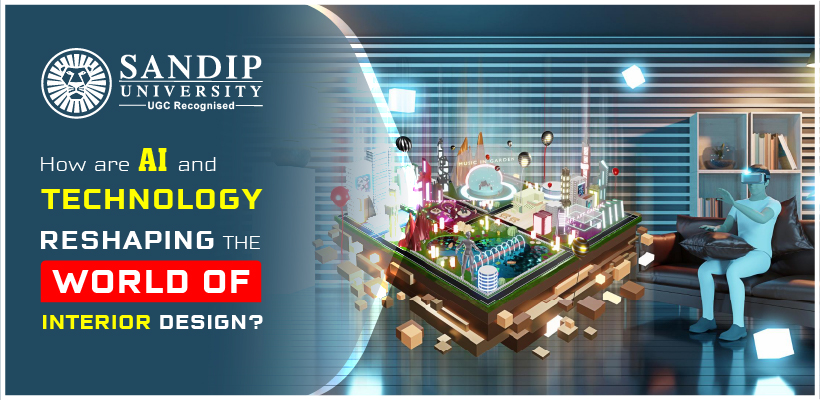Artificial intelligence (AI) and technology are revolutionising nearly all fields today, and the same applies to interior designing as well. As space optimisation and creative spaces become the need of the hour, the interior designing industry has also evolved to accommodate modern clients. This evolution has brought on the need to integrate AI and technology into interior designing to help keep up with latest market trends and client demands. Many top interior design colleges in Nashik offer futuristic and tech-integrated interior design programs to train budding interior designers with the right tools.
The world of AI and technology is vast and while there are many positives, technology always comes with its own set of challenges as well. Let us take a look at the impact of AI and technology on interior design, and the advantages and challenges of integrating AI and technology in interior designing:
Ways in which AI and Technology are Reshaping Interior Design
- AI-driven Design Tools
AI-driven design tools are being adopted by interior designers to help them visualise and build better ideas at a much faster pace. AI-powered software is now at the forefront of interior designing with tools that help interior designers create unique designs on the go. Professionals can colour match to create a pleasant living or workspace, and use client inputs to create multiple designs in minimal time.
- Recommending Personalisation
AI and technology-backed tools now help interior designs make astute personalisation recommendations that can help them satisfy client requirements. Based on the inputs given by the clients, interior designs can recommend exact colours and textures of the furniture, colour pallets, and materials that are tailor-made to match client requirements. This saves time and helps build client satisfaction.
- Integrating VR and AR
Virtual reality (VR) and augmented reality (AR) are excellent technological advancements reshaping interior designing. Virtual reality tools help clients with an immersive experience where they can understand the look and feel of the space even before construction begins on a project. Augmented reality tools provide a realistic visual of a space complete with décor and furniture to help clients make informed decisions on the go.
- Automated Project Management
Integration of AI and technology in interior design makes the management of different projects much easier. It helps small as well as large interior design firms as such apps and tools help integrate project timelines, manage budget, prioritise tasks for team members, automate repetitive tasks, and propose innovative ideas to match client requirements. Managing projects efficiently frees up time for creative thinking and visualisation for interior designers.
- Intelligent and Sustainable Materials
Intelligent and sustainable materials are becoming popular in the interior design industry. Intelligent materials are those that interact with a given environment to build a comfortable space for clients. These include light-sensitive paints, thermal-reactive interiors, adaptable glass, etc. Sustainable materials are those that are sourced from environmentally-safe areas without harming natural ecosystems. Eco-friendly and conscious living will be reshaping the interior design industry in coming years.
- Collaborative Tools
AI and technology have come a long way where collaborative tools help save time and increase efficiency. Such tools are usually cloud-based and can be accessed from anywhere through a secure network. These tools can facilitate real-time collaborations and discussions between clients, designers, design stores, contractors, and all other entities involved in the designing and construction process.
- Forecasting Market Trends
AI-driven tools can help interior designers forecast upcoming design trends based on the data input that can be analysed by such tools. Social media and other technologies also positively help interior designers keep up with changing scenarios in the industry. The end result is that designers are able to provide clients with futuristic, trendy, and efficient designs that can elevate the clients’ lived experience in the long run.
Benefits of AI and Technology in Interior Design
There are many benefits to the integration of AI and technology in interior design. The top advantages are:
- Efficient use of resources is possible through AI and technology as such tools facilitate better time management, collaborations, and generate pleasing designs on the go.
- Positive client experience is possible as AI-based tools help zero-in on the client requirements, and provide an immersive experience through AR and VR.
- Cost-effective designs and plans are possible through AI-based tools as they help designers work within a budget, explore markets for sourcing materials, and adjust pricing efficiently.
- Innovative design ideas and options are generated by AI and can help designers build on their creative process by exploring uncharted avenues for optimal client satisfaction.
Challenges of AI and Technology in Interior Design
While there are many advantages to AI and technology in interior designing, there are some challenges of such technological advancements as well. These are some of the shortcomings of AI and technology in interior designing:
- Lack of human touch can pose a problem for certain clients who expect a more people-based design experience, as AI-based tools can eliminate the human factor from the equation.
- Extreme dependence on available data can limit the scope of predicting future trends and impact AI-generated designs as they are highly dependent on quality data.
- Moral and ethical concerns can arise from the integration of AI and technology in interior design due to issues regarding transparency and loss of intellectual property in the field.
- Initial costs can be high as the cost of adopting AI-driven technology can be a costly affair for interior designers, irrespective of the scale of their operations.
Conclusion
In conclusion, AI and technology are thoroughly reshaping the interior designing industry. The future of interior design with technology is very bright and has many advantages to revamp the industry. If you are keen on building a career in this field, you can opt for Sandip University’s interior design programs to train with the best faculty and gain excellent placement or entrepreneurial opportunities. Design a bright new career in interior designing with Sandip University!

